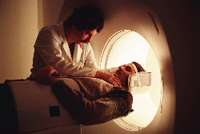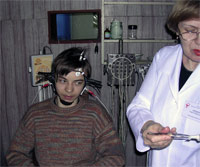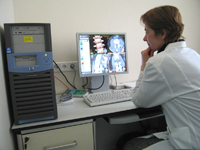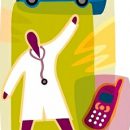Epilepsy in matters and answers.
Content
Question number 11. What problems may occur when a kindergarten is visited by a child?
Problems begin from the moment when you simply refuse to take a child in kindergarten. This is quite justified if a child may not be ensured in this children's institution.
Pretty good reasons for failure are frequent attacks in a child, a rough physical or mental delay in development. If the child's attacks flow in a light form and they are quite rare, and the development delay is poorly expressed, the refusal to visit the kindergarten is unreasonable.
And yet, despite certain difficulties, it would be more useful to send a child not to a specialized, and in an ordinary kindergarten, since education and communication in the environment of ordinary, non-deprecated peers may be useful for subsequent social development. But if a child has expressed a delay in development, then special care and classes are possible only in a specialized kindergarten.
Question number 12. What is the feature of the role of parents of a sick child?
When the parents first learn about the diagnosis of the child, then, as a rule, their first reaction to this news is shock and rejection. However, the more information over time they receive about epileptic attacks and their characteristics of their child, the less panic, their attitude and more adequate assessment of the situation. But even in this case, parents often experience serious disappointment due to the fact that the child will not be able to justify all their hopes in the future.
It is very important that parents initially reasonably, creatively behaved in relation to the child, tried to properly organize the conditions for its full life and development. And for this requires close interaction with the attending physician, kindergarten, school, rehabilitation center. Unfortunately, quite often parents show little and succumb to panic, fears, shame and doubts in their own power, which further aggravates the situation and causes harm to the child.
Question №13. How to help the right social formation of a child with epileptic attacks?
Give the child as much independence as possible because it is – The foundation of his further adult life. Of course, calmer when the child is always «In the eyes», But much more important than your complacency to give the child a chance to become a full-fledged person who does not need a permanent care. How healthy children will independently know the world and act on the basis of their own experience, the world and children with epilepsy should also know, no matter how difficult it is to accept these parents.
Never use epilepsy as a reason to avoid any unpleasant or just unwanted for you or child action. In the family, do not take a child with an attacks, do not put it in an exceptional position compared to brothers and sisters. He can accurately perform orders around the house – help in cleaning, wash the dishes and t.NS.
Attacks should not be used as a reason for evasion of unpleasant duties. Otherwise, in childhood, in childhood to such tricks, he will continue to use them in difficult situations, which, in turn, can lead to psychological problems associated with reluctance «Party» with attacks.
Question №14. What sports can be engaged?
Sport is an important and necessary component in the life of any person. Sport – This is the possibility of Shi Rocky contacts with other people, the ability to feel and evaluate your own strength, dexterity, skill. In addition, it is a significant step in the formation of independence and vital activity.
Rocky contacts with other people, the ability to feel and evaluate your own strength, dexterity, skill. In addition, it is a significant step in the formation of independence and vital activity.
However, the decision on classes in one way or another sport should be taken, given not so much of their positive aspects, how much frequency of attacks of epilepsy, the time of their occurrence and the degree of danger in connection with this very sports discipline.
In the presence of frequent seizures, it is impossible to do such sports that are conjugate with the danger of injuries, such as sports gymnastics, acrobatics, boxing, struggle, riding riding, cycling, water jumps, scuba diving, alpine skiing, mountaineering. If the attacks flow in a dream, or at the time of awakening, it is possible to compromise and choose a sport with a minimum risk, such as rhythmic gymnastics, aerobics, sports games (football, volleyball, handmade ball).
At school in the lessons of physical education, if the child has no attacks, you can do physical education under the supervision of the teacher.
Proper compliance with the recommendations for the choice of sport type minimizes the risk of injury during sports activities.
Question №15. In what cases is allowed swimming?
For people with epilepsy, swimming classes are essentially limited due to their incompatibility with probable attacks. The occurrence of an attack in water is definitely dangerous for life, but it should be noted that it happens quite rarely. When admitting to swimming a person with epilepsy, the following points must be taken into account:
- It is impossible to float with frequent uncontrolled attacks, general ailment or in the preference of the attack;
- It is not recommended to swim in cold water;
- You can not jump into the water from the tower and dive;
- It is necessary to choose a quiet time in the pool and avoid large accumulation of people and various holidays on the water;
- It is desirable to have a brightly colored swimming cap, which makes it easier to monitor floating in water;
- Having swimming a person with epilepsy is recommended to be held in a pair with another person (the so-called «twin method») or under whose observation.
If the observing is not able to assist water, it is preferable to swim in places with a small depth and the edge of the pool.
Question №16. Is it harmful to watch TV?
Viewing TV can cause attacks about 1% of people with epilepsy with high sensitivity to the action of light. Such attacks are called photosensitive. If they are poorly treatable, then when watching TV, the following rules must be compliance:
- It is no closer to 2 meters from the screen;
- give preference to a smaller television screen;
- use high speed televisions (100 Hz);
- Posted during viewing so that the eye level is not higher than the screen level;
- Watch TV in the illuminated room;
- close one eye when viewing kaleidoscopic filming, flashes, flashing pictures to reduce the effect of flicker;
- Use a remote remote control to control the TV.
Question number 17. Is it possible to visit discos?
Most young people with epileptic attacks can visit discos. Conventional color-choke effects for them are safe. The attacks can only provoke stroboscopic (often flickers) bright glare in a darkened room in people with a photosensitive form of epilepsy.
The probability of appearing attacks directly depends on the frequency of flashes and brightness of light effects. In addition, it is necessary to remember that such constant discos satellites, such as lacking, fatigue and alcohol can also contribute to the emergence of attacks.
Question №18. Did children with epilepsy video games are harmful?
Most experts believe that video games themselves do not cause attacks, but those games in which contrast light effects are used can cause attacks in people with increased sensitivity to flashes light. During the game, the same rules must be followed as when watching a TV or computer work.
Question №19. Is it dangerous to work at the computer?
Assumptions about provoking influence on attacks work at a computer are greatly exaggerated. However, people with increased sensitivity to flashes light, such concerns are justified, although they are not a categorical contraindication to work with a computer.
With properly selected treatment and observance of a number of protective measures, you can not deprive the person of pleasure (or necessity) work at the computer. At the same time, it is desirable to comply with some rules:
- The distance from the eyes to the monitor screen should be at least 35 cm (for 14-inch screens);
- The monitor screen must be clean with the correctly adjusted image parameters;
- The computer must be installed in a bright room;
- The monitor must be positioned so as to avoid glare from the windows or other light sources;
- When choosing a monitor, give preference to the SVGA standard with a rapid frequency of at least 60 Hz;
- eliminate other monitors or televisions from sight;
- Avoid programs that use most of the screen as a light background, or reduce the working window of the program with a change in the window background to less contrast (preferably with the presence of green tones);
- Avoid viewing small image details on the screen at close range;
- try not to work at a computer in an excited or overworkable state, with a lack of sleep or in a state of alcohol intoxication.
It should be borne in mind that the computer can become an important factor in the social formation of a person with epileptic attacks. The computer makes it possible to work with educational and developing programs, receiving the information you are interested in, communicating with Versters and much more, without which it is difficult to present modern life. In addition, the ability to work on the computer increasingly in recent years is a mandatory requirement when taking.
Versters and much more, without which it is difficult to present modern life. In addition, the ability to work on the computer increasingly in recent years is a mandatory requirement when taking.
Question number 20. MO
whether to drink alcohol?
Some people with epilepsy prefer not to use alcoholic beverages at all. It is well known that alcohol can provoke attacks, but it is largely due to the individual susceptibility of man, as well as the form of epilepsy.
If a person with attacks is fully adapted to a full-fledged life in society, he will be able to find a reasonable solution to the problem of alcohol consumption. Allowed doses of alcohol use per day are for men – 2 wine glasses for women – 1 glass.
Question №21. Is it possible to smoke?
Smoking is harmful – This is well known. The direct link between smoking and the emergence of attacks was not detected. But there is a danger of fire if the attack will arise while smoking unattended. Women suffering from epilepsy should not smoke during pregnancy, so as not to increase the risk (and so high enough) malformations in the child.
Question №22. For what you need groups «self-help»
?
Groups «self-help» exist in many countries. They are united by both the people themselves with epilepsy and their close relatives. The need to create such groups comes from the urgent needs of patients with epilepsy in communication, interaction and mutual assistance. Concern to uniform problems allows you to solve them more efficiently, in particular, thanks to the possibility of submitting them to together in various social structures.
Interaction with people having similar illness reduces the sense of rejection, loneliness, isolation, and also solves the problem of contacts. One of the most important goals that set themselves the group of self-help patients with epilepsy – These are their psychological adaptation in life.
New and promising form of mutual assistance of people with epilepsy is the Internet. Numerous information services are currently organized - WWW servers, teleconferences and epilepsy newsletters. Internet allows you to quickly get new information on epilepsy.
You can send a message to the newsletter indicating the existing problems and get answers from medical professionals and from other people with epilepsy and their loved ones who want to share their experiences in a similar situation or simply to provide moral support.
Read start










